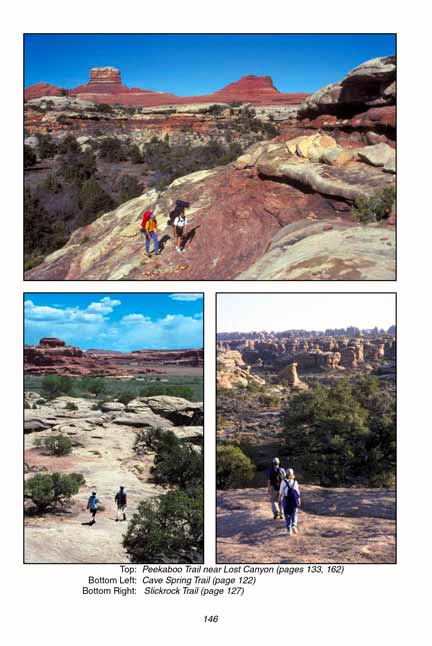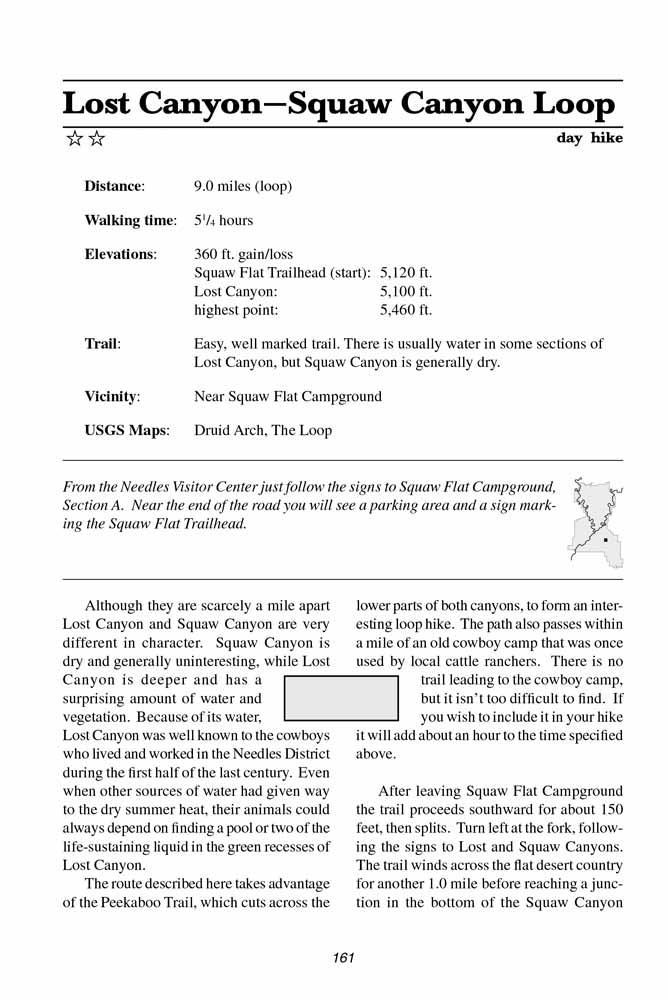Lost Canyon Squaw Canyon
excerpted from our book
Canyonlands National Park
Favorite Jeep Roads & Hiking Trails
pages 161-163
|
Buy book directly from the author!
Canyonlands National Park
Favorite Jeep Roads & Hiking Trails
- has access info for 75 trailheads
- 56 detailed trail maps
- 241 photographs
- loads of driving and hiking tips
|
regularly $14.95
now on sale for only
$11.95
click here
for book orders
|



 Although they are scarcely a mile apart Lost Canyon and Squaw Canyon are very different in character.
Squaw Canyon is dry and generally uninteresting, while Lost Canyon is deeper and has a surprising amount of water and vegetation.
Because of its water, Lost Canyon was well known to the cowboys who lived and worked in the Needles District during the first half of the last century.
Even when other sources of water had given way to the dry summer heat, their animals could always depend on finding a pool or two of the life-sustaining liquid in the green recesses of Lost Canyon.
Although they are scarcely a mile apart Lost Canyon and Squaw Canyon are very different in character.
Squaw Canyon is dry and generally uninteresting, while Lost Canyon is deeper and has a surprising amount of water and vegetation.
Because of its water, Lost Canyon was well known to the cowboys who lived and worked in the Needles District during the first half of the last century.
Even when other sources of water had given way to the dry summer heat, their animals could always depend on finding a pool or two of the life-sustaining liquid in the green recesses of Lost Canyon.
The route described here takes advantage of the Peekaboo Trail, which cuts across the lower parts of both canyons, to form an interesting loop hike.
The path also passes within a mile of an old cowboy camp that was once used by local cattle ranchers. There is no trail leading to the cowboy camp, but it isnít too difficult to find.
If you wish to include it in your hike it will add about an hour to the time specified above.
After leaving Squaw Flat Campground the trail proceeds southward for about 150 feet, then splits. Turn left at the fork, following the signs to Lost and Squaw Canyons.
The trail winds across the flat desert country for another 1.0 mile before reaching a junction in the bottom of the Squaw Canyon drainage.
This junction marks the beginning of the loop through the two canyons.
It doesnít make much difference which direction you take around the loop, but I will describe a clockwise direction here with the initial part of the walk through Lost Canyon and the return through Squaw Canyon.
After crossing Squaw Canyon the trail continues for another mile before dropping down a slickrock slope into the head of a small, unnamed arroyo.
It then winds along the sandy bottom of the ravine for another 0.8 mile before coming to a three-way junction in the middle of a large intersecting wash.
A Park Service sign in the wash will tell you that you have reached Lost Canyon.
If you wish to take a detour to the historic Lost Canyon cowboy camp you will have to leave the trail at this point and begin walking down the canyon in a northerly direction.
(This side trip is described below in more detail.) Otherwise, turn right here and continue south along the trail that heads up the bottom of Lost Canyon.
The trail continues up Lost Canyon for a distance of 2.0 miles before climbing out the northwest side to the top of a ridge that separates Lost Canyon from Squaw Canyon.
From there the path immediately drops back down to the bottom of Squaw Canyon and proceeds north for 1.9 miles to the beginning of the loop.
Finally, you must retrace your steps the last 1.0 mile back to the Squaw Flat Trailhead.
 The Lost Canyon Cowboy Camp
The Lost Canyon Cowboy Camp
Cattle ranching was much different in the early 1900s than it is today.
There were few motor vehicles and fewer roads to drive them on; consequently tending cattle often meant spending weeks or even months away from home.
For many of the cowhands the range was home, and they often tried to establish semi-permanent camps where they could rest and cook their food nearer their work.
Cave Spring, near the Visitor Center was one of these camps; the Lost Canyon Camp was another.
To get to the Lost Canyon cowboy camp you must turn north at the point where the Peekaboo Trail crosses the bottom of Lost Canyon and hike down the dry streambed for 1.0 mile.
The going is difficult in a few places because of the thick underbrush that now grows in the canyon, but if you try to stay just above the streambed on the west side you will encounter less brush.
Donít look for a trail; there is none.
After you have been walking for 25 minutes start watching the left bank for a large alcove.
The alcove lies behind a row of cottonwood trees 50 feet northwest of the streambed and about 20 feet higher.
Unfortunately the underbrush makes it impossible to see the floor of the alcove from the canyon bottom, but if you look carefully you can see some of the cowboy graffiti higher up in the back of the alcove.
The alcove is about 150 feet long, 25 feet deep and 30 feet high. It is well protected from the rain, and must have once been a very comfortable home away from home.
It appears that little has changed in the Lost Canyon camp for many decades.
The old grub box where the old-timers once stored their food is still there, and there is even a small table nearby as well as many old cans, bottles, boxes, and pieces of Dutch ovens and other cooking implements.
There is an old steel drum still half filled with grain that the cowboys must have used to feed their horses, and in one corner a big pile of hay where someone must have made his bed.
But perhaps the most interesting part of the old cowboy camp is the cowboy graffiti on the walls.
The rocks are adorned with several charcoal drawings of horses, numerous names and initials, and even what appears to be a wanted poster for Negro Bill, a black cattle rancher who lived in Moab during the late 1800s.
The oldest dated signature I could see on the walls was ďEllis Hatch, 1919Ē.
What fascinating tales the walls of the sheltered camp would tell if they could talk.
We can only image the long-forgotten men that must have gathered here in days past, and the yarns they must have exchanged to pass the lonely nights.
Now all that remains is a small collection of artifacts, signatures, and drawings, but these simple treasures offer a priceless window through which visitors can imagine what life in the camp was like so long ago.
Enjoy their presence, but please donít be tempted to remove anything. Here the relics are treasures, but in another context they would be of little value to anyone.
Also, refrain from the urge to add your name to the signatures the old cowboys scratched onto the walls of the alcove.
Leave the Lost Canyon cowboy camp as you find it, so that others too can enjoy this rare connection with Utahís past.
Note to web developers: You may copy this material onto your site, but in return please include a link to my home page
www.utahtrails.com. Thank you, David Day (utahdavidday at gmail.com)
Click here to see more trails in
Canyonlands National Park
© Rincon Publishing Company, all rights reserved
|



 Although they are scarcely a mile apart Lost Canyon and Squaw Canyon are very different in character.
Squaw Canyon is dry and generally uninteresting, while Lost Canyon is deeper and has a surprising amount of water and vegetation.
Because of its water, Lost Canyon was well known to the cowboys who lived and worked in the Needles District during the first half of the last century.
Even when other sources of water had given way to the dry summer heat, their animals could always depend on finding a pool or two of the life-sustaining liquid in the green recesses of Lost Canyon.
Although they are scarcely a mile apart Lost Canyon and Squaw Canyon are very different in character.
Squaw Canyon is dry and generally uninteresting, while Lost Canyon is deeper and has a surprising amount of water and vegetation.
Because of its water, Lost Canyon was well known to the cowboys who lived and worked in the Needles District during the first half of the last century.
Even when other sources of water had given way to the dry summer heat, their animals could always depend on finding a pool or two of the life-sustaining liquid in the green recesses of Lost Canyon.
 The Lost Canyon Cowboy Camp
The Lost Canyon Cowboy Camp